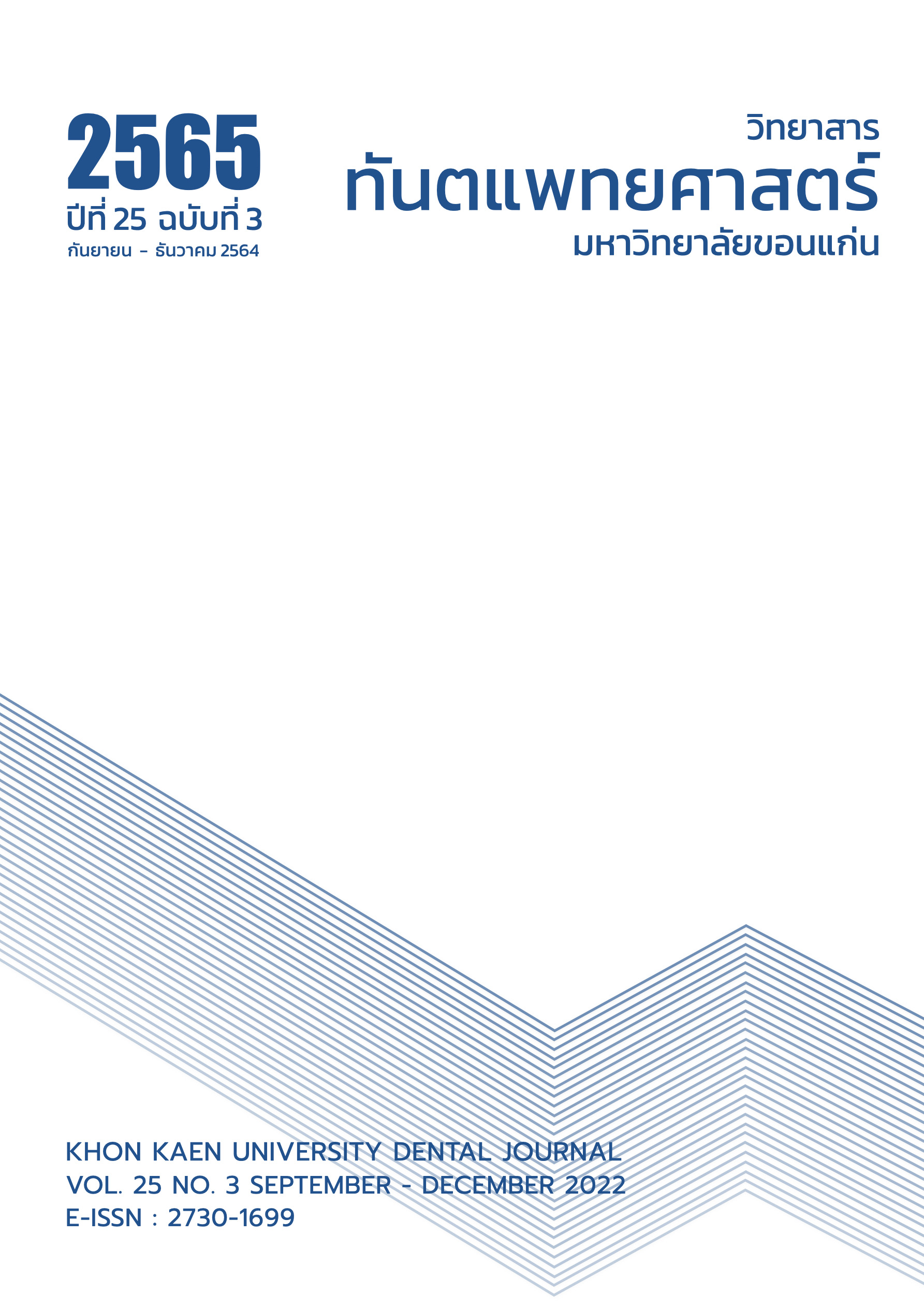In Vivo Study of Brushing Force Produced by Three Types of Toothbrush Filaments from Two Brands
Main Article Content
Abstract
Manual tooth brushing is a tool used for maintaining daily oral health. The purpose of this in vivo study was to investigate tooth brushing force produced by three types of filament from two brands of manual toothbrush. The study enrolled 36 healthy volunteers. Tooth brushing force was measured using a force transducer and a physiological recording system. All volunteers were instructed to brush using the modified Bass technique. Three filament types from Berman® and Oral-B® were assessed in this study. We found that the diameters of the filaments from Berman® medium, soft, and extra soft toothbrushes were 360.19±2.31, 277.04±2.16, and 142.89±18.42 µm, whereas those from Oral-B® were 312.22±3.82, 270.33±3.76, and 195.18±13.65 µm, respectively. The brushing force with Berman® medium toothbrush was significantly higher than that with the soft and extra soft toothbrushes, whereas the brushing force of Oral-B® medium toothbrush was higher than that of the extra soft toothbrush. Although Oral-B® soft toothbrush and Berman® soft toothbrush had similar filament diameter, the former required more brushing force. It was concluded that toothbrush filament types (diameter) could affect brushing force and should be considered when selecting suitable toothbrush for each oral condition.
Article Details

This work is licensed under a Creative Commons Attribution-NonCommercial-NoDerivatives 4.0 International License.
บทความ ข้อมูล เนื้อหา รูปภาพ ฯลฯ ที่ได้รับการลงตีพิมพ์ในวิทยาสารทันตแพทยศาสตร์ มหาวิทยาลัยขอนแก่นถือเป็นลิขสิทธิ์เฉพาะของคณะทันตแพทยศาสตร์ มหาวิทยาลัยขอนแก่น หากบุคคลหรือหน่วยงานใดต้องการนำทั้งหมดหรือส่วนหนึ่งส่วนใดไปเผยแพร่ต่อหรือเพื่อกระทำการใด ๆ จะต้องได้รับอนุญาตเป็นลายลักษณ์อักษร จากคณะทันตแพทยศาสตร์ มหาวิทยาลัยขอนแก่นก่อนเท่านั้น
References
Litonjua LA, Andreana S, Bush PJ, Cohen RE. Toothbrushing and gingival recession. Int Dent J 2003;53(2):67-72.
Ganss C, Schlueter N, Preiss S, Klimek J. Tooth brushing habits in uninstructed adults--frequency, technique, duration and force. Clin Oral Investig 2009;13(2):203-8.
Ganss C, Klein P, Giese-Kraft K, Meyners M. Validation of motion tracking as tool for observational toothbrushing studies. PLoS One 2020;15(12):1-13.
Breitenmoser J, Mörmann W, Mühlemann HR. Damaging effects of toothbrush bristle end form on gingiva. J Periodontol 1979;50(4):212-6.
Rotpenpian N, Yakkaphan P. Review of literatures: Physiology of Orofacial Pain in dentistry. e-neuro 2021;8(2):1-7.
Wiegand A, Burkhard JP, Eggmann F, Attin T. Brushing force of manual and sonic toothbrushes affects dental hard tissue abrasion. Clin Oral Investig 2013;17(3):815-22.
Rotpenpian N. Review literature: Pathophysiology of dentine hypersensitivity. SWU dent J 2020;13(2):94-103.
Van der Weijden GA, Timmerman MF, Versteeg PA, Piscaer M, Van der Velden U. High and low brushing force in relation to efficacy and gingival abrasion. J Clin Periodontol 2004;31(8):620-4.
Alexander JF, Saffir AJ, Gold W. The measurement of the effect of toothbrushes on soft tissue abrasion. J Dent Res 1977;56(7):722-7.
Van der Weijden FA, Campbell SL, Dörfer CE, González-Cabezas C, Slot DE. Safety of oscillating-rotating powered brushes compared to manual toothbrushes: a systematic review. J Periodontol 2011;82(1):5-24.
Wang Y, Sibaii F, Custead R, Oh H, Barlow SM. Functional Connectivity Evoked by Orofacial Tactile Perception of Velocity. Front Neurosci 2020;14:1-13.


